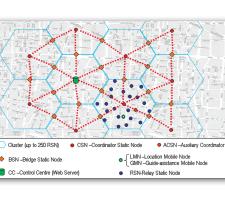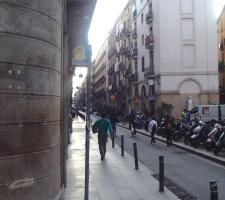
Steve Lane, Commercial Director at Triteq, talks about the successful deployment of
Unlike other wireless technologies, ZigBee requires very little maintenance and is easily extendable; this allows devices to be added to networks with virtually no administration. Its cost advantage allows it to be widely deployed to create an extensive network with low power demands, and while it was originally developed to cover small local areas, recent developments in the technology are allowing its use across much wider urban and city environments (see Sidebar, 'Why choose ZigBee?').
Metropolitan network in Barcelona
In a project intended to explore the potential of ZigBee, an urban network was put to the test in Barcelona. This project, CityBee, was a part of the
CityBee set out to develop a solution to assist vulnerable people in the city context and ZigBee was chosen over many other location and communication technologies for the reasons listed above. This was in the belief that the benefits for installers, operators and users of the CityBee network would ensure as wide an uptake as possible. The project had to identify work that was needed to bring a usable system together. This included: developing multi-cluster networks to expand the limited number of 'nodes' available on a single network, thus enhancing the ability of Zigbee to work across a wider area; evaluating the performance of ZigBee in a variety of urban situations including open areas, wide streets, narrow streets and alleys; evaluating signal propagation delays over a multi-cluster network; and developing suitable location algorithms to enable user location, both indoors and in an urban environment.
Triteq was a key partner in the project and focused on designing the ZigBee network to provide location, directions and emergency assistance for vulnerable groups within society. These included groups such as children, the elderly, and both physically and mentally handicapped people. The ZigBee network was set up in the Nou Barris district of Barcelona, where a public institution for people with disabilities is located.
The network was designed to be flexible and scalable to cover a variety of scenarios, from large metropolitan areas up to the entire city, if eventually required. With the nature of the project, it was also essential that the network would work both indoors and outdoors. The technical structure of the ZigBee network was relatively simple and consisted of numerous static nodes relaying information backwards and forwards between themselves and individuals' mobile devices. A network control centre then processed this information. The network was divided into clusters of static nodes and in turn, a multi-cluster network was then formed, which could be extended across the city if necessary. CityBee's multi-cluster network is shown in Figure 1.
Application-specific devices
Triteq's role included developing concepts for different devices for each group of vulnerable people that could benefit from using the ZigBee network. For individuals requiring location/tracking support, such as children or mentally handicapped people, small, unobtrusive devices that could be fitted to clothing or worn as a bracelet or necklace were required. These devices were designed to have a battery life of more than six months.
Other devices could be used to provide directions and guidance. These included both a text and audio function, so that the visually impaired could receive information verbally through an audio interface. The project touched on the most common forms of information delivery, but ultimately it is the design of the user's mobile device that determines how complex the information format can be. In fact, ZigBee can be used to deliver information in almost all forms, with text, audio and even colour images. It is down to the skill of the product designer to produce a mobile device that provides the most suitable form of communication.
Feasibility demonstrations
To demonstrate the feasibility of the system in an urban environment, a number of prototype network devices were designed and the project team carried out extensive testing in different locations from open parkland through to narrow streets (Figure 2). This enabled the radio performance to be assessed and criteria for setting up the network to be established. Testing was taken one step further and in-building tests of the network were conducted, allowing the development of location algorithms for this type of scenario. The conclusion of the project was the installation of a network over a 1km square area in Barcelona to demonstrate both the system operation and performance of the location algorithms in a practical urban landscape. Figure 3 shows a test node in open parkland.
Future work
The Barcelona project has proven the efficacy of ZigBee as an urban communication system. Triteq has already started work to test further such networks' utility in applications where tracking and monitoring are important (see Sidebar, 'Solutions for urban transport') and discussions are currently under way to move the project into a wider-area test network, based on enclosed environments, as a monitoring and tracking user exercise. This includes theme parks and zoological gardens where the system could be used to follow visitor movements and allow improved management of attractions. Other advantages can be presented for the location of 'lost' children - either as an information service to visitors or as a service provided by a venue. It is hoped that a suitable location can be set up for limited trials over the winter season, with reporting by the end of this period. Other possibilities being considered are for care homes and shopping malls to provide people with location services within these environments.
Solutions for urban transport
Systems for traffic control and management have evolved around current radio technologies. Real-time bus and train information has generally been developed around GSM or private radio systems. These technologies may continue to offer advantages in this type of application but ZigBee would have its own benefits in certain situations.
Potentially, transport and mobility applications for ZigBee technology which take advantage of its capabilities for information delivery include relaying the latest transport service travel information. This could involve delivering information on waiting times at bus and tram stops or updates on rail networks to commuters. It would also be possible to have a live information service or urban guide for visitors to the city. These could operate through mobile devices or fixed display screens.
ZigBee's characteristics make it particularly well suited to monitoring applications such as the management of city street lights. In this case, a network could be created that was linked to street lights with the ability to control or monitor lights through the network's control centre. In a similar way, a ZigBee network could also be used to control and monitor street signage (and the lighting of signs).
Solutions which count vehicles and utilise ZigBee already exist, and ZigBee networks could be established with sensors for counting pedestrians and vehicles across whole cities. This would be a simple, ongoing solution for traffic monitoring which would require little expense or maintenance. Likewise, a system for environmental monitoring via a ZigBee network could be set up. In this case, devices could be linked to the network to measure fumes and noise levels, with information being relayed back to a control centre.
In addition, ZigBee networks could be used to support the police, medical or fire services. A network could be set up to track the location of emergency service vehicles (fitted with the appropriate tracking sensors) and the information used to synchronise traffic signals with the arrival of emergency vehicles.
Why choose ZigBee?
There are several commercially available wireless systems that have been and could be used for data and communication systems in an urban environment. Some of these will be familiar and all have their own unique features which make them suitable for particular applications.
GSM/GPRS is familiar as the mobile phone system and can also be used for data delivery and collection. This requires a licence to operate and equipment must conform to operator and international standards.
Equipment is relatively expensive and requires a network contract to be used, so call charges are required for all data transferred. Advantages include a wide user base, international standards and readily available devices which, although expensive, can be used for delivery of information. Location services are already available but require GPS for better precision, which suffers inside buildings or narrow streets.WLAN (802.11) is familiar as wireless LAN in the home and office. Networks of intermeshed nodes can be established with high bandwidth but subsequent increases in power requirements. Consumer devices, including some mobiles and PDAs already have WLAN but these can be expensive. No licence fee is required but charges to connect to existing networks may exist.
Mesh networking means that multiple routes back to a server may exist for a signal. It is possible to get good location from WLAN networks but currently this is really only practical within enclosed environments such as buildings. WLAN has a higher power requirement to keep the network active.
Bluetooth is designed as a paired device-to-device communication method and networks of devices are impractical.
ZigBee has some limitations, such as a limited signal range (200m) and limited penetration of signal through building materials (although in some circumstances this can be an advantage). Low bandwidth makes it unsuitable for video or audio although it could be used to trigger an audio or video display in the users' device.
However, ZigBee offers: mesh networking capabilities; radio module availability at cost-effective prices (around a quarter the cost of WLAN); low-cost, licence-free technology with world-wide standards; the ability to build private networks; very low power consumption, particularly for handheld devices, offering long battery life at low cost and the option of solar power; operations without call charges or monthly contracts. It is ideal for control and simple message systems.













